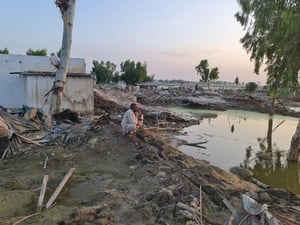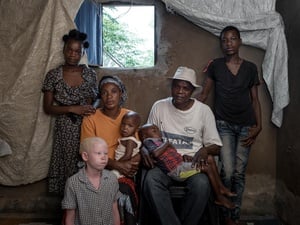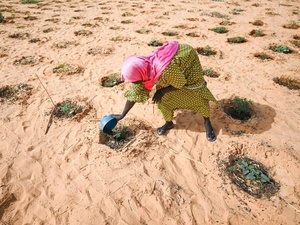Frequently asked questions on climate change and disaster displacement
Frequently asked questions on climate change and disaster displacement

Girls cross a bamboo bridge on Katubidia island in Bangladesh, a nation where millions of people are at risk due to rising sea levels.
As activities get underway in Marrakech at COP22, the 22nd Conference of Parties to the United Nations Framework Convention on Climate Change, here are answers to some frequently asked questions about climate change and displacement.
1. How many people are already displaced by climate change?
Displacement linked to climate change is not a future hypothetical – it’s a current reality. An annual average of 21.5 million people have been forcibly displaced by weather-related sudden onset hazards – such as floods, storms, wildfires, extreme temperature – each year since 2008. Thousands of others flee their homes in the context of slow-onset hazards, such as droughts or coastal erosion linked to sea level rise. There is high agreement among scientists that climate change, in combination with other drivers, is projected to increase displacement of people in the future.
Climate change is also a “threat multiplier” in many of today’s conflicts, from Darfur to Somalia to Iraq and Syria. The Arab Spring is commonly seen as leading to Syria’s conflict, but people tend to forget the five-year drought in Syria’s northeast that preceded the war and the displacement of some 1.5 million people. Climate change sows seeds for conflict, but it also makes displacement much worse when it happens.
2. Which regions are most at risk?
No region is immune from climate change, but the risks of displacement are greatest for countries with high exposure to hazards and with large populations in areas that lack the capacity or resources to adequately prepare. Asia sees more natural hazards than any other region – in 2015, 85 per cent of people displaced by sudden onset disasters were in South and East Asia. For example, flooding in the southern Indian states of Tamil Nadu and Andhra Pradesh caused 1.8 million people to be displaced, while Cyclone Komen and monsoon floods in both Myanmar and India led to displacement of 1.6 million and 1.2 million people respectively. However, Asia is the region with the largest percentage of global population. When considering population size, Vanuatu and Tuvalu were hit hardest in 2015 when Cyclone Pam displaced 55 and 25 per cent respectively of the countries’ populations.
In general, low and lower-middle income countries have the most displacement linked to disasters, including in the context of climate change.
3. What is a “climate change refugee”?
The term “climate refugee” is misleading because in international law the word “refugee” describes people fleeing war or persecution and who have crossed an international border. Climate change affects people inside their own countries, and typically creates internal displacement before it reaches a level where it pushes people across borders. It is therefore preferable to refer to “persons displaced in the context of climate change”.
4. How many people will be displaced by climate change in future?
It is hard to say. What we know is that the extent and severity of displacement often depends on how well countries are prepared and can mitigate the effects. Strengthening preparedness is something we hope Marrakech COP22 meeting will help bring about.
5. How is displacement addressed in the Paris Agreement?
The Paris Agreement includes three important elements for displacement and human mobility issues.
- The Agreement’s Preamble recognizes that climate change is a common concern of humankind and includes a reference to migrants, asking Parties to respect, promote and consider their respective obligations towards migrants, among others, when taking actions to address climate change.
- The Paris Agreement contains many references to the protection of people, the resilience of communities and the importance of livelihoods. These are essential entry points for addressing environmentally-linked root causes of forced displacement such as access to water, food, energy, and the need for livelihood opportunities to enable people to remain where they live.
- Finally, the Paris Agreement requests the Executive Committee of the Warsaw International Mechanism (WIM) on Loss and Damage to establish a task force on displacement. This task force will “develop recommendations for integrated approaches to avert, minimize and address displacement related to the adverse impacts of climate change.” This is also an acknowledgment of the dangers of displacement and a welcome recognition of climate change as a factor of displacement.
6. What does UNHCR want to see happen at COP22?
UNHCR would like to see the following addressed in Marrakech:
- Sufficient resources are provided for the successful and timely implementation of the work of the Warsaw International Mechanism (WIM) Task Force on displacement.
- Human mobility is mainstreamed into States’ planning tools, such as Nationally Determined Contributions (NDCs).
- States commit to support communities already displaced in the context of disasters, and also take actions to prevent and reduce the risk of future displacement.
- The resilience of populations most at risk is strengthened to allow them to remain where they are.
- Countries are supported with technical advice to prepare for relocating populations out of harm’s way, as a last resort, and in full consultation with all affected populations.









